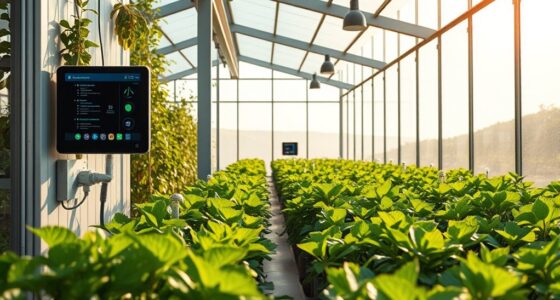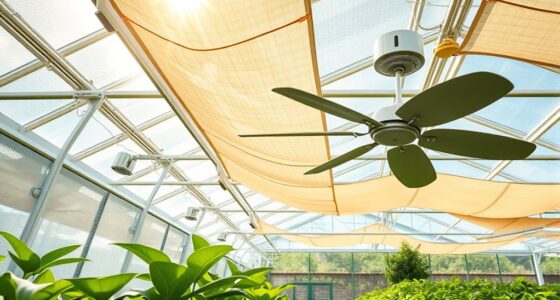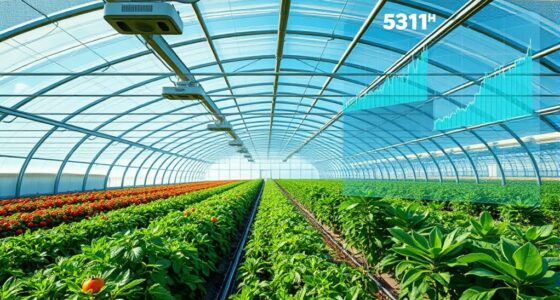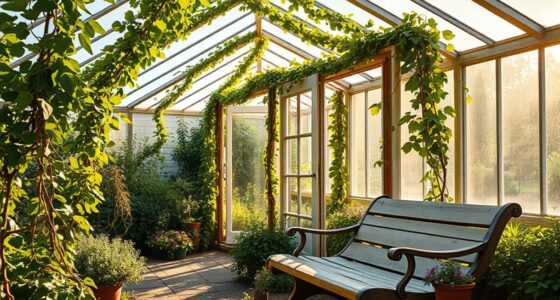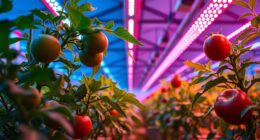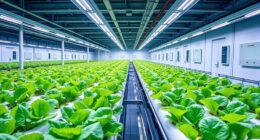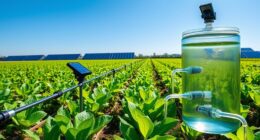Using 3D printing in greenhouse design lets you create custom, eco-friendly parts and prototypes quickly. It boosts efficiency by allowing you to produce precisely fitting components and experiment with innovative designs without delays. This approach reduces waste through sustainable materials like recycled plastics, enhancing your greenhouse’s environmental impact. Plus, it streamlines manufacturing, ensuring consistent quality and faster implementation. To discover how these advancements can transform your projects, keep exploring what 3D printing offers.
Key Takeaways
- Enables rapid creation of customized, eco-friendly greenhouse components tailored to specific design needs.
- Facilitates quick prototyping and testing of innovative structural and functional parts.
- Supports sustainable materials like recycled plastics, reducing environmental impact.
- Ensures precise fit and complex geometries that improve greenhouse efficiency and performance.
- Automates production workflows for consistent quality and faster implementation of design modifications.
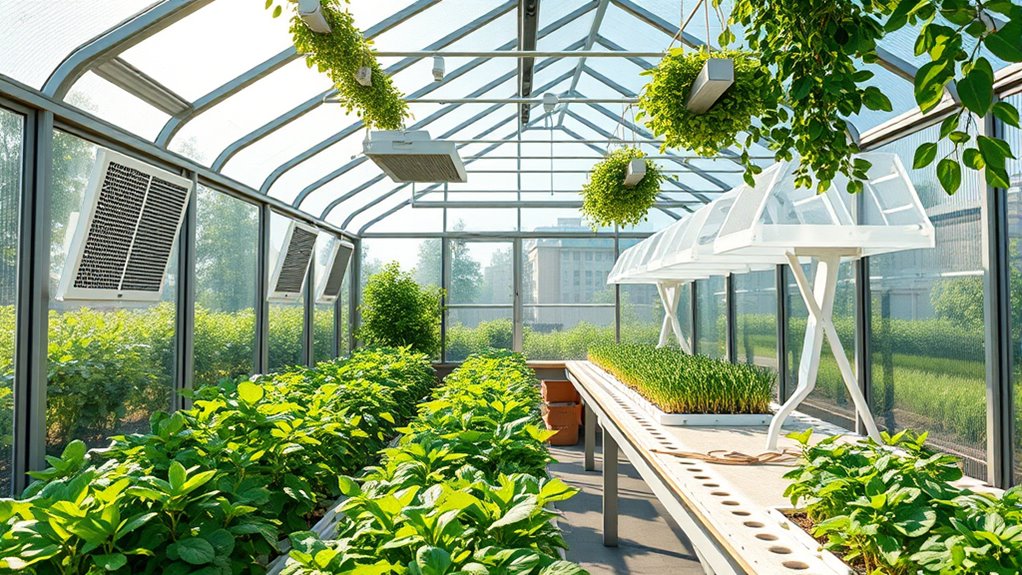
Have you ever wondered how 3D printing is transforming greenhouse design? It’s a game-changer, especially when it comes to creating custom parts and prototypes quickly and efficiently. Using 3D printing, you can craft components tailored precisely to your greenhouse’s needs, reducing waste and cutting down on the time it takes to bring ideas to life. One of the most exciting aspects is the ability to utilize sustainable materials, which means you’re not just improving your greenhouse but also minimizing your environmental footprint. Instead of relying on traditional manufacturing that often involves heavy machinery and excess waste, 3D printing allows you to produce parts on demand, using eco-friendly filaments like biodegradable plastics or recycled composites. This shift supports sustainability while giving you the flexibility to experiment with new designs.
3D printing revolutionizes greenhouse design with custom, eco-friendly parts and rapid prototypes, enhancing sustainability and innovation.
Additionally, the high precision of 3D printed components ensures better color accuracy and fit, which is crucial for the functional integrity of your greenhouse parts. Automated systems play a significant role here, making the entire process more seamless. Once you design a part digitally, the 3D printer takes over, building it layer by layer with minimal manual intervention. This automation speeds up production and ensures high precision, so your custom parts fit perfectly and function reliably. Whether you need specialized brackets, vents, or connectors, you can quickly prototype and iterate without waiting for traditional manufacturing cycles. This rapid iteration capability means you can test different designs, refine them, and implement improvements faster than ever before, ultimately leading to a more efficient greenhouse.
Furthermore, the integration of sustainable materials into your prototypes not only enhances environmental benefits but also aligns with growing industry trends toward eco-conscious innovation. You can experiment with bio-based or recycled filaments that align with eco-conscious practices, making your greenhouse more sustainable overall. Plus, because 3D printers can produce complex geometries that might be difficult or costly to manufacture traditionally, you gain the advantage of innovative, lightweight structures that optimize airflow, lighting, or insulation. These custom parts can enhance your greenhouse’s performance while reducing material waste, thanks to precise printing techniques.
Furthermore, with the advancements in automated systems, you can set up a streamlined workflow where digital designs are sent directly to the printer, which then operates unattended. This level of automation means fewer errors, consistent quality, and faster turnaround times for your prototypes and replacement parts. As a result, you can respond swiftly to any structural or functional issues, ensuring your greenhouse remains at peak efficiency. Incorporating digital fabrication techniques can further streamline your production process and open up new possibilities for customization. Learning about asset division laws can also help you plan for future investments or expansions, ensuring your innovative solutions are sustainable long-term. Overall, integrating 3D printing with sustainable materials and automated systems empowers you to create tailored, eco-friendly solutions that elevate your greenhouse design and maintenance, making it more adaptive, sustainable, and innovative.
Frequently Asked Questions
How Cost-Effective Is 3D Printing for Large-Scale Greenhouse Projects?
When considering cost-effectiveness for large-scale greenhouse projects, you should conduct a thorough cost analysis to compare 3D printing with traditional methods. While 3D printing offers customization and rapid prototyping, scalability challenges can increase expenses as project size grows. For smaller or highly specialized parts, it’s cost-effective, but for extensive, uniform components, traditional manufacturing might be more economical. Balancing these factors helps determine if 3D printing suits your project’s scale and budget.
What Materials Are Best Suited for Outdoor Greenhouse 3D Printed Parts?
When choosing materials for outdoor greenhouse 3D printed parts, you should focus on UV resistant plastics and weatherproof materials. These guarantee your components withstand sunlight, rain, and temperature changes without degrading. Materials like ABS, PETG, and certain nylon variants are ideal because they offer durability and resistance to environmental elements. Selecting the right weatherproof and UV resistant plastics helps your greenhouse parts last longer and perform reliably in outdoor conditions.
How Durable Are 3D Printed Components in Varying Weather Conditions?
Is durability a promise or a gamble? When considering weather resistance and material longevity, you find that 3D printed parts can withstand varying outdoor conditions if you choose the right materials, like ABS or ASA. These materials offer excellent resistance to UV, moisture, and temperature fluctuations. While no material is invincible, selecting durable filaments guarantees your components stay strong and functional, weathering the storm with resilience.
Can 3D Printing Accommodate Complex Geometries for Innovative Greenhouse Designs?
You can definitely use 3D printing to create complex geometries that support innovative designs. Its flexibility allows you to produce intricate shapes and structures that traditional methods might struggle with, making your greenhouse truly unique. By leveraging 3D printing, you streamline the development process, customize parts easily, and push the boundaries of conventional greenhouse design, ensuring your project stands out with advanced, functional, and visually appealing features.
What Are the Environmental Impacts of Using 3D Printed Parts in Greenhouses?
Imagine a greenhouse where every part whispers sustainability. Using 3D printed parts reduces waste through precise, sustainable manufacturing, cutting down excess material. You can choose recyclable materials, minimizing environmental impact. This approach promotes eco-friendly practices, conserving resources, and lowering carbon footprints. By embracing material recyclability and sustainable manufacturing, you help create a greener future, ensuring your greenhouse remains a thriving haven for plants and the planet alike.
Conclusion
By now, you see how 3D printing transforms greenhouse design with custom parts and prototypes. It offers flexibility, cost-efficiency, and rapid innovation. Are you ready to embrace this technology to optimize your greenhouse? With 3D printing, you can tailor solutions that meet your unique needs and accelerate your project’s success. Don’t let traditional methods hold you back—step into the future of sustainable, innovative horticulture today.



